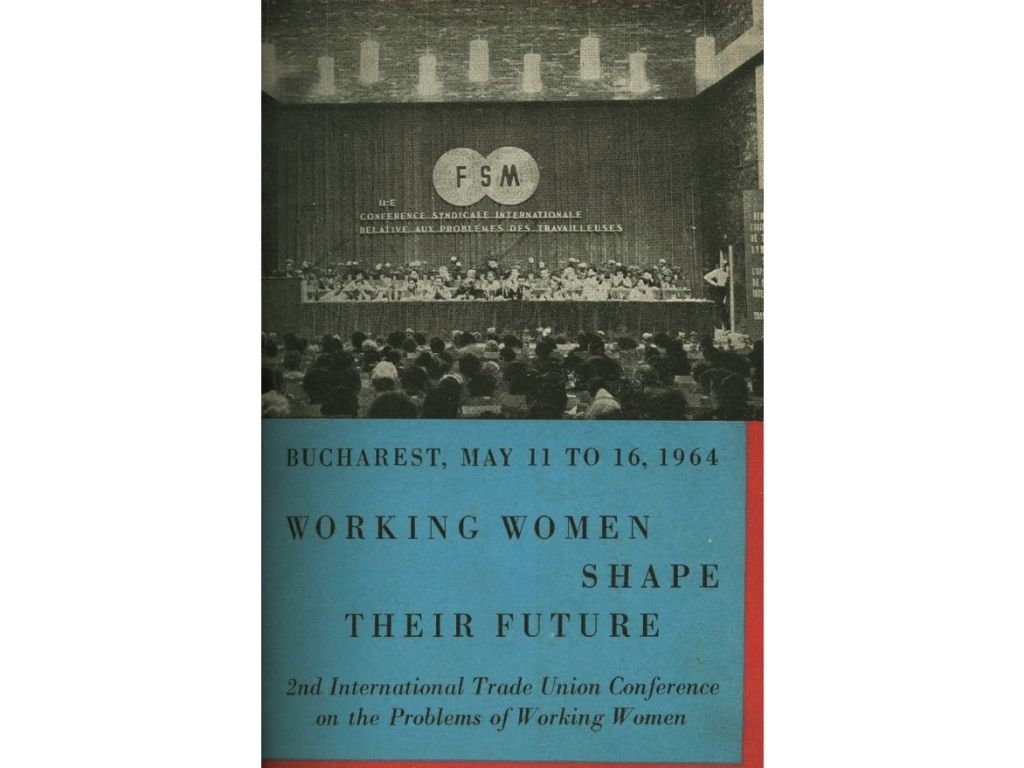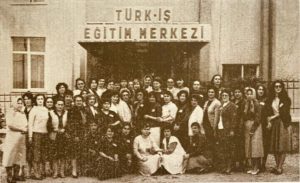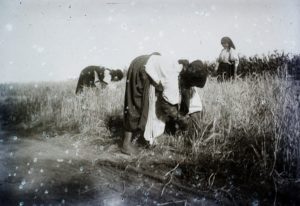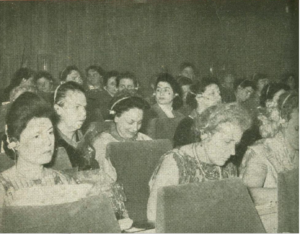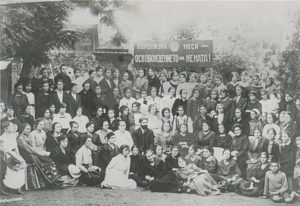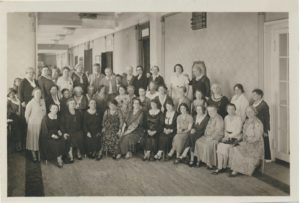by Alexandra Ghit, Olga Gnydiuk, Eszter Varsa
Illustration: The title page of the World Federation of Trade Unions’ brochure “Working Women Shape Their Future. 2nd International Trade Union Conference on the Problems of Working Women.” Women and Social Movements, International (Prague: Práce, 1964).
In 1964, between May 11 and 16, the World Federation of Trade Unions (WFTU) organized, not for the first time, a conference of women workers. It was an international gathering of working women in Bucharest, attended by 332 participants from 55 countries from Africa, Latin America, Europe, and Asia. More than 60 speakers gave speeches at the conference and discussed action aimed at improving working conditions, the defense and promotion of trade union rights and other economic and social demands, and the struggle for peace, democracy and national independence.[1] This conference was one of the numerous post-war scenes on which women activists from different countries met, collaborated, shared experiences, drafted programs of actions and adopted memorandums, appealed to national governments and international organizations. Reading about such internationally organized action one might ask: How can the integration of the history of a conference such as this one into the study of women’s labour activism advance our knowledge about activism and activist women’s stances and goals? Does “thinking transnationally” bring a substantive change to our understanding of the history of women’s labour activism in the long perspective? Why write the history of women’s labour activism from a transnational perspective?
The posts in this series invite readers to think more deeply about these issues. From the beginnings of their organizing in the latter half of the nineteenth and then throughout the twentieth century, women labour activists in Eastern Europe were not confined within the borders of states and empires but participated in a variety of cross-border and transnational networks and international organizations, and exchanged information, within and beyond the borders of states and empires. Activists and functionaries were connected to various international and transnational (socialist, communist, Catholic, Jewish, etc.) labour organizations, both as part of male-dominated and women-only structures. They were also involved in women’s organizations and networks addressing concerns of working women. Among these organizations were the Second International, the International Labour Organization (ILO), the Red International of Labour Unions, the International Cooperative Women’s Guild, the International Federation of Working Women, the WFTU, the International Confederation of Free Trade Unions, the Women’s International Democratic Federation, and many more. In these fora women’s labour activists discussed and aimed to advance not only labour protection and gender equality measures and a plethora of reforms concerned with women’s rights and women’s work, but also the issues of peace, human rights, development and anti-colonial struggle, and the struggle against racism.[2]
An investigation of the circulation and exchange of ideas, organizational practices, repertoires, and agendas of activism across borders and regions poses new questions on and reveals new insights into how these processes shaped women’s work and labour activism in different local contexts and on how activists from Eastern Europe and elsewhere contributed to the making and shaping of the international politics of women’s work. Posts in the previous series of this blog, on activist biographies, already brought to the surface examples of transnational connections, networks, actions, and long-term effects. Gabriele Proft was active in the interwar international socialist movement and the International Federation of Trade Unions. Bulgarian communist women (among them Ana Maimunkova) participated in the Second International Communist Women’s Congress in Moscow in 1921. Polish labour inspector Halina Krahelska forged significant transnational ties especially through involvement in the ILO. Migration and cross-border mobility, whether determined by economic need (as was the case for young Proft) or by deportation (as happened to Krahelska), had an important influence on these women’s lives. These and many other similar experiences require a framework of analysis not provided by nation-state-centric historiographies.
Historians of women’s labour activism should explore such connections and interactions and analyze the travel and translation of forms of organizing and ideas motivating and shaping activists’ agendas and repertoires of action. Yet, we need to integrate the transnational sphere and the history of international organizing into our research agendas in a creative and nuanced manner.
The historiography of the international organizations founded from the late nineteenth century onwards has begun to explore the history of transnational transfers between Eastern Europe and the rest of the world. In fact, women labour activists forged transnational links not primarily for the sake of connection. They aimed to influence global developments especially as the sphere of international relations expanded to include non-governmental actors, multilateral organizations, and new topical agendas, and they contributed to these same processes. They were keen to participate in internationally organized action partly to compensate for their lack of inclusion in their own contexts. Significantly, women’s involvement in both formal and non-formal international settings repeatedly had an impact on how they framed their agendas, sometimes expanding, streamlining, or modifying their aims and demands. This, in turn, could have an impact on their self-positioning and action in domestic contexts. Women’s transnational action also contributed to both challenging, reproducing and transforming global economic inequalities and unequal international relations. A good example to illustrate this phenomenon is the genealogy of international “gender equality” policies.[3] One might well ask how the international struggle over sex-specific labour legislation versus the advancement of the legal equality doctrine in labour law played out before World War II in Eastern European settings where entrepreneurial interests often trumped (men’s as well as social reformers’ interests in) women-specific labour protection. One might also ask whether and how the unwavering state-socialist conviction that equality and difference must and could easily be combined in labour law, without generating any detrimental effects for women, contributed to the longevity of the international commitment to women-specific labour protection.
The study of women’s labour activism can thus sharpen our knowledge about exchanges between the inter- and transnational and the local, national, and regional level. It has become a truism in recent scholarship that these exchanges have always been multidirectional. Research on Eastern Europe has begun to show that this region did not only stand at the receiving end of international-level action on behalf of these organizations. Rather, local actors actively influenced the topical agendas as well as the scope of action of these organizations.[4] Not only did the transnational context and the agendas of transnational organizations influence Eastern European women labour activists’ local-level engagement but these activists themselves contributed to the development of these organizations’ agenda-setting on behalf of working women. They were thus involved in shaping the transnational context of women’s labour organizing.[5] The study of women’s labour activism in Eastern Europe needs to explore how transnational power inequalities, material imbalances, divergent perceptions, and evaluations of the experiences and views of labour activists from different regions impacted both transnational cooperation and local practices of labour activism.
For the history of women’s labour activism, a transnational approach is also key in exploring issues connected to labour migration. In this regard, we need to address the question of how nation-based institutions related their agendas to the needs and problems of workers moving across borders: Did, and when and why did, trade unions and other organizations and institutions seek to create fairer labour conditions for all, and when and why did they tend to isolate or even entirely keep out the migrant workers they may have perceived as competitors to the domestic labour force?[6]
In sum, a transnational and international approach helps to construct more inclusive historical narratives, can be employed to critically interrogate processes of social and economic hierarchization that played out in settings that transcended nation-states and can direct our attention to gendered spaces of opportunity available to or generated by women who combined activism at home with activism in inter- and transnational settings.
The six blog posts to be published in this series over the course of the next four months will deal with women’s labour activism in various transnational settings and time spans. They will address transnational and translocal exchanges and developments that were connected in a variety of ways with organized actions in various local workplaces and labour environments. The blog posts will discuss, e.g., the contacts and ties of the Women’s Department of the Bulgarian Communist Party with the International Women Secretariat of the Comintern in the early 1920s, the labour activism of women from Eastern Europe in the Labour and Socialist International between 1923 and 1940, and in the WFTU after 1945, as well as the transnational processes and actors involved in establishing local educational structures and programs for women workers organized in labour unions in Turkey in the 1980s.
Update: In this series, we published five instead of six blog posts.
References:
[1] World Federation of Trade Unions, Working Women Shape Their Future. International Trade Union Conference on the Problems of Working Women. Women and Social Movements, International (Prague: Práce, 1964).
[2] Boris, Eileen, Dorothea Hoehtker, and Susan Zimmermann, eds. Women’s ILO: Transnational Networks, Global Labour Standards, and Gender Equity, 1919 to Present, Studies in Global Social History, vol. 32. (Leiden, Boston: Brill, 2018); Cobble, Dorothy Sue, For the Many: American Feminists and the Global Fight for Democratic Equality (Princeton, New Jersey: Princeton University Press, 2021).
[3] Zimmermann, Susan, “Equality of Women’s Economic Status? A Major Bone of Contention in the International Gender Politics Emerging During the Interwar Period,” The International History Review 41, no. 1 (November 2017): 1-28, https://doi.org/10.1080/07075332.2017.1395761. See also Dolinsek, Sonja, and Philippa Hetherington, “Socialist Internationalism and Decolonizing Moralities in the UN Anti-Trafficking Regime, 1947-1954,” Journal of the History of International Law/Revue d’histoire du droit international 21, no. 2 (2019): 212-238.
[4] See e.g. Iacob, Bogdan, Corina Doboș, Raluca Grosescu, Viviana Iacob, and Vlad Pașca, “State Socialist Experts in Transnational Perspective. East European Circulation of Knowledge during the Cold War (1950s-1980s): Introduction to the Thematic Issue,” East Central Europe 45, no. 2-3 (2018):145-159, https://doi.org/10.1163/18763308-04502006; Hadler, Frank and Matthias Middell, eds. Handbuch einer transnationalen Geschichte Ostmitteleuropas, vol. 1, Von der Mitte des 19. Jahrhunderts bis zum Ersten Weltkrieg (Göttingen: Vandenhoeck & Ruprecht, 2017); Mark, James, Artemy Kalinovsky, and Steffi Marung, eds. Alternative Globalizations: Encounters between the Eastern Bloc and the Postcolonial World (Bloomington: Indiana University Press, 2020).
[5] Donert, Celia, “From Communist Internationalism to Human Rights: Gender, Violence and International Law in the Women’s International Democratic Federation Mission to North Korea, 1951,” Contemporary European History 25, no. 2 (2016): 313-333.
[6] Hoerder, Dirk, “Transnational, Transregional, Transcultural: Social History and Labor Migrants’ Networks in the 19th and 20th Centuries,” in Transnationale Netzwerke im 20. Jahrhundert. Historische Erkundungen zu Ideen und Praktiken, Individuen und Organisationen / Transnational Networks in the 20th Century, ed. Berthold Unfried, Jürgen Mittag, Marcel van der Linden, and Eva Himmelstoss. ITH-Tagungsbericht 42 (Leipzig: Akademische Verlagsanstalt, 2008), 81-98.

